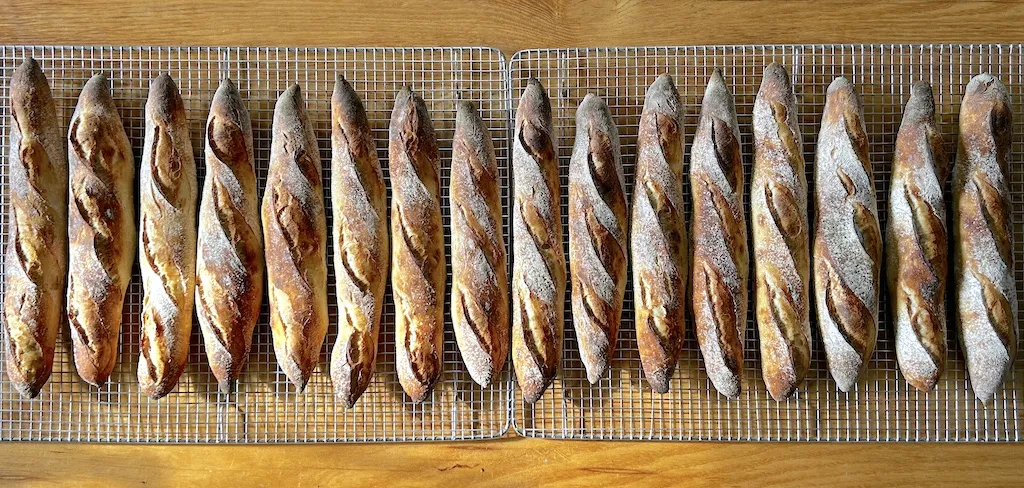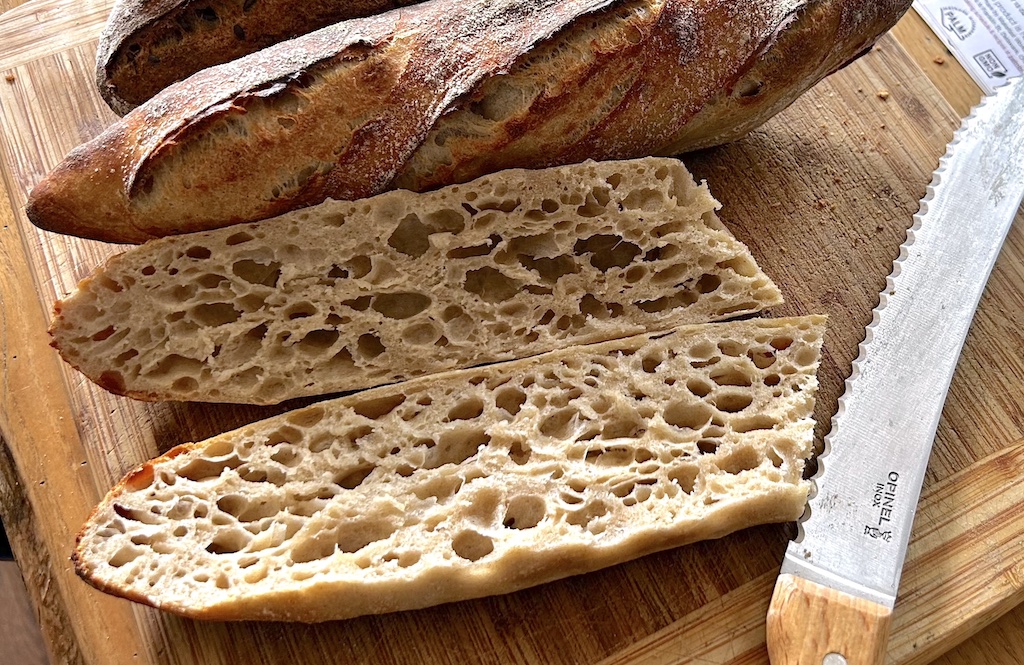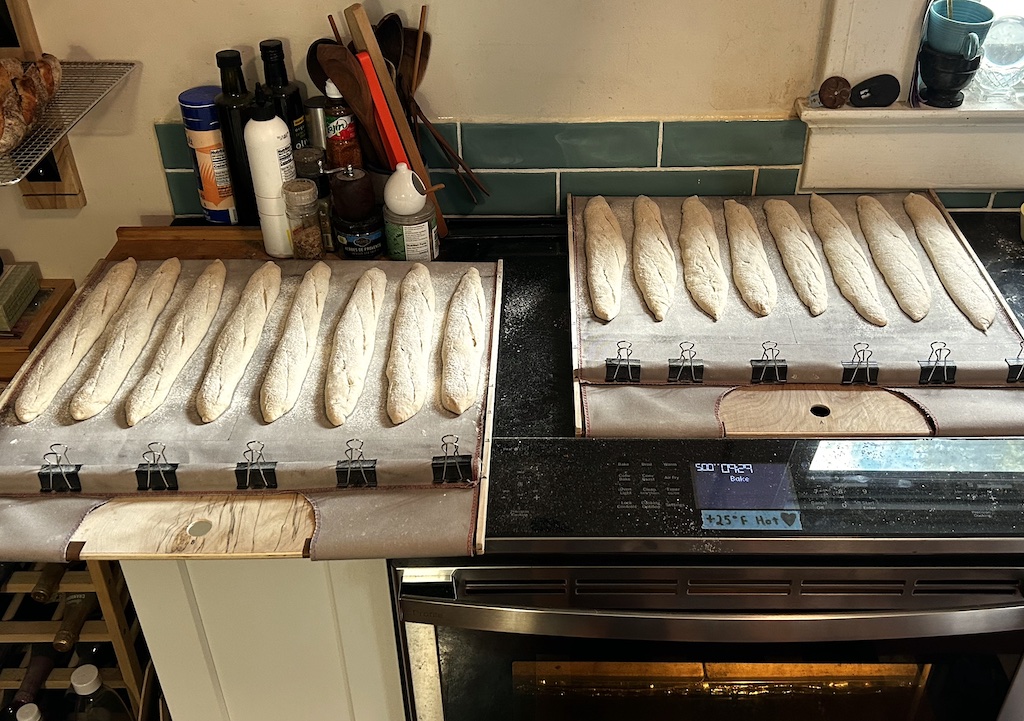
Hey TFL,
I've been reading recipes/thoughts from here for years and experimenting non-stop. After getting quite a few elements to click and finally start making great bread (in fairly unconventional ways), I figure it's only fair to share back with the community! :)
For context: I've always enjoyed bread, but after living in Europe (France/Lux) for a few years, I truly fell in love with it. I'd seek out the best bakeries I could find and try the most natural/levain-based loaves they had. I experimented a bit at home, but just purely to learn. Then I moved back to the US (Ohio) about 9 years ago and quickly realized that it was nearly impossible to find anything like the bread I had grown to love in Europe. The closest similar bread I could find was a 45min drive and cost $15-20/loaf.
So I dove head-first into trying to bake it myself -- baking 2-4 loaves/week and adjusting every parameter I could think of to see what worked best for me with a standard home oven. As the bakes improved (and neighbors started asking about it), I started looking into what it would take to scale up while still doing it from home. After lots of research into cottage food laws, it became an exciting reverse engineering project to back solve how I could make the most great bread possible without investing everything I had into a brick-and-mortar bakery.
It's still a work-in-progress (i.e. any feedback would be much appreciated!), but it's also at a point where I imagine sharing some of the process could be inspiring to other home bakers looking to grow.
--
I've found the Respectus Panis method to be incredible in terms of both flavor and general approach (room temp bulk, long fermentation, and lower salt). Always looking to improve -- any feedback would be super helpful.
The resulting demi baguettes have a deeply caramelized crisp crust, tender crumb with open/wild alveoli, a creamy color, and a complex lightly tangy wheat flavor from the long fermentation. The 200g size is also great for making sandwiches or cutting in half and toasting for tartines.
~~~~
Demi Baguette de Tradition recipe (makes 16 @ 200g each):
- 2.4g Whole wheat 50/50 Active Levain
- 1305g Water (filtered, cold)
- 0.14g Yeast (instant, 4g/tsp)
( - - swish levain/water/yeast to combine - - )
- 1419g Organic Bread Flour (12.7-14.1% protein)
- 473g Organic T80-T90 Flour
- 26g Kosher Salt (1.35% of flour weight)
Mix all together by hand (no need for autolyse with such a long bulk), then rest an hour and give it a stretch-and-fold or two to develop the dough.
Total bulk resting time is 20 hours at room temp (70°F).
Then divide into 200g portions, bench rest ~15 minutes, knock out any large bubbles, roll/shape into demi baguette (14-16" long), and immediately place onto loader.
Oven should be fully preheated until baking stones reach 525°F.
Before loading into the oven, slash 3 times with a lame/razor (at a low angle to encourage grigne/ears).
Bake at 525°F w/ steam for 12 min, then open door for about 3 seconds (to vent steam), and change to 575°F+Fan for 4-6 min (to develop the crust via Maillard reaction).
Cool 30+ min on a rack before serving/bagging (must be < 100°F to limit any chance of condensation).
~~~~

This recipe is for 70°F ambient temperature. If your kitchen is cooler/warmer, you'll want to increase/decrease your levain and yeast accordingly (+/-15% for -/+4°F).
And yes, it really does use such tiny amounts of levain and yeast! I actually use a milligram scale to measure the yeast because it's important to get just the right amount for such a long room-temp bulk. And for what it's worth, this bread still falls well within the "pain au levain" definition, since it has much less than 0.2% of flour weight as yeast (only 0.007%).
From experimentation I've found that the combination of bread flour and T80-T90 flour (at a 75:25 ratio) comes very close to approximating the flavor/ash of a French T65 flour. You can of course substitute with different flours, but will likely need to also adjust the hydration to match.
Oh, and loading this many baguette into the oven at a time onto baking stones is a lot easier with a couple of DIY dough loaders! I shared a version of these on here years ago (https://www.instructables.com/id/DIY-Dough-Loader/), but I've tweaked it a bit to make it more fool proof with the cloth wrapping all the way around a plank to keep the motion more consistent.

And here's a pic of my current oven setup. Two decks made using side-by-side 3/4" thick stones. Takes about 75 minutes to fully come up to temp, but transfers heat to the bottom of loafs very nicely once hot.

I've been selling these baguette locally (via PALM bread / Le Phare) for a few months now, but seems like I learn something new every week. I've been inspired by lots of bakes on the fresh loaf and appreciate all of the discussion to help bakers improve their craft. Hope this can nudge some more bakers to give scaling up a try.
Happy baking!
And stunning results. All the best with your business.
I'm constantly humbled by the process and how much more there is to learn. Nice to hear I'm at least on the right track :)
Very nice work, I wouldn't change a thing with those results.
Beautiful looking loaves, and I can hardly imagine baking 16 at once in my oven. Very impressive!
How did you learn that you could get these results without a final proof stage?
TomP?
Thanks! My goal was to get to 100+ baguette in a baking day. I had been doing final proofing in a couche and kept playing with stone temperature to get the right spring/crust when baking.
I noticed that when I got the stones above around 520F, even the tiny bubbles in the dough seemed to open up nicely when baked. And then I was running behind and rushed a bake one day (only about 15 minutes in the couche) and the crumb was just as good as the longer proofed loaves I had baked!
So naturally, I started tinkering and realized (at least for me) all of the traditional baguette shaping, transferring to couche, waiting, and transferring back to load in the oven wasn't actually gaining me anything. After a few bakes without the final proof/couche baguette dance, I haven't gone back. And it's a LOT simpler and less space/time consuming.
The only caveat is that you want to pop any large bubbles if you notice any. The tiny bubbles will win out and create a nice crumb, assuming you don't accidentally trap large air pockets when shaping (or somehow still have a big bubble from bulk).
According to the sources I read about "respectus panis", much importance is placed on the long ferment and the final proof is sometimes shortened or eliminated. The perfect maturity and development of the dough should be achieved during this time so that a final proof might not be needed and could even cause overproofing and collapse.
It sounds like an interesting and easy method, as long as all the quantities and conditions are met (e.g. micro amounts of leavening agents).
Those baguettes look incredible, and the dough loader is genius. Where did you find those baking stones? I'm currently using a steel, but it transfers the heat a bit too quickly, and I've had a hard time finding stones that are the right size for my oven (I need 17" x 23" total).
For the baking stones, I use two 11x16" cordierite baking stones placed side-by-side (making a 22"x16" deck area). That leaves a 1/2" gap around the sides for heated air to circulate while still providing maximum baking area. And using two stones instead of 1 giant stone makes it less prone to breaking as things heat/cool. It also allows for placing a thermocouple between the stones (if you have one) to see what the stone temp actually is when pre-heating for the next round of bakes.
Specifically, I used American Metalcraft PS1116 11x16" (via WebstaurantStore) - not cheap, but good quality.
Totally optional, but I also placed a thin L-shaped aluminum channel along the front/back to support them on my oven rack since they are fairly heavy.
Oh, and for the dough loader... here's what it looks like in use (on some 420g bâtards) so you can see how it works. When In the next week or so I'm planning to also freely share the specific dimensions/CAD files over on palmbread.com in case others want to build one, too :)
Thanks for sharing!
Yippee
The baguettes look good and your system seems to be working well for a home oven for high volume output. I could never get my baguettes to brown on the sides when they were crowded together but the extra mass must radiate heat sufficiently. I made a similar version of the Super Peel with the same materials you used that has been working for me for years. I like the rails you added to rest it on the stone.
The recipe and process is an interesting method. I was wondering what the benefits of a room temperature proof are versus a cold proof like the Bouabsa recipe that I have been using also with a relatively short final proof. I am guessing the small amount of sourdough is more of a flavor enhancement than a leavening agent.
Best wishes for your business venture because there are not enough good baguettes in this world.
Don
Thanks, Don. Yeah, they do just get brown on the sides with 8 per deck. Baking only 6 per deck does brown them just a bit more, but it's not particularly noticeable (and baking more at a time means I can sell them for less; currently $3/loaf and that's using organic flour).
I estimate that the sourdough actually does about half of the leavening. The other breads I make (primarily 420g bâtard of various flour/seed/grain mixes) use only sourdough starter, at about 1.75x the amount (3.3g of levain for 2.5kg of dough), and the rise is fairly similar (with an even more pronounced sourdough flavor).
The room temperature bulk process of respectus panis really is amazing. Fantastic flavor, and no fridge space required! Just give yourself a few bakes to develop a feel for how the dough evolves and when the proofing is on-point (read: pay careful attention to ambient room temperature -- a few degrees can change your bulk time by an hour or more).